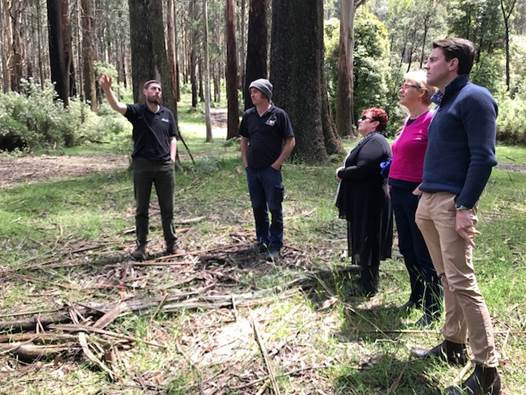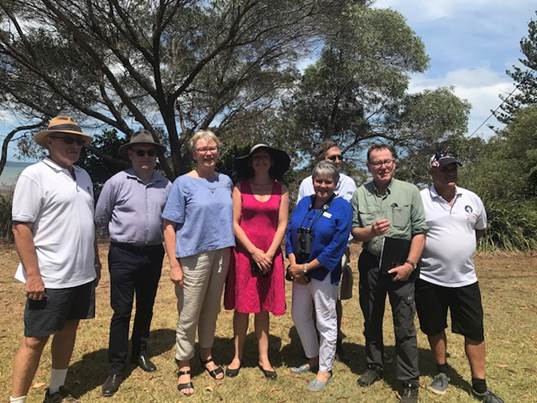Summary of committee site visits
This appendix contains summaries of the committee's site
visits undertaken during the inquiry. These visits were to:
- the Toolangi State Forest and the Healesville Sanctuary, in the
Yarra Valley, Victoria; and
- the site of proposed developments by Walker Group Holdings
(Walker) at Toondah Harbour in Cleveland, Queensland.
Site visit: Toolangi State Forest and Healesville Sanctuary
On 21 November 2018, Senators Rice, Duniam and Urquhart
visited sites in the Yarra Valley in Victoria: the Toolangi State Forest; and
the Healesville Sanctuary.
Toolangi State Forest
The visit to Toolangi State Forest was hosted by Professor
David Lindenmayer, Professor of Ecology and Conservation Science at the Fenner
School of Environment and Society, at the Australian National University (ANU),
and two ANU research officers based in the Victorian central highlands, Mr
Lachlan McBurney and Mr David Blair.
The committee visited a number of sites in Toolangi State
Forest, and received in situ briefings, as follows:
- coupes where logging has recently been undertaken, which have not
yet been re-planted. This included sites where forestry activities have left
buffer zones around areas where threatened species have been located prior to
logging;
- sites showing the effects of bushfires. This included the
recovery of areas damaged in the 'Black Saturday' bushfires of 13 April 2009,
as well as the long-term and lasting effects of the 'Black Friday' bushfires of
1939;
- areas of old growth forest and forest areas that include
individual old trees that provide habitat to threatened species, including the
critically endangered Leadbeater's Possum, the vulnerable Greater Glider, and
many species of birds whose populations have been declining;
- newer areas of regrowth forests, including areas representing up
to two decades of regrowth;
- water catchment areas in the Toolangi State Forest that feed the water
reservoirs supplying Melbourne and other parts of southern Victoria; and
- sites where long-term monitoring of animals occurs, including
possums, gliders and birds, undertaken by the ANU research team directly, as
well as through programs they run for members of the public to participate in
monitoring species population.
The committee looked at sites of old growth mountain ash,
which provide critical habitat for populations of animal species, including the
critically endangered Leadbeater's Possum. These possums nest in hollows of
mountain ash, which almost always require trees to be around 150–years old
before they develop. The committee looked at conservation strategies that have
been explored with limited success, including artificial hollows and nesting
boxes. Professor Lindenmayer noted that populations had declined, with site
occupancy for Leadbeater's Possum around half of rates two decades ago.

Professor Lindenmayer gives
an in situ briefing at a coupe in Toolangi State Forest to Senators Rice,
Urquhart and Duniam
The committee considered the different burning patterns of
old growth and younger regrowth forests. Professor Lindenmayer explained that
younger forests burned with greater severity, as they are more prone to
crown-scorching fire patterns. This has effects not only on the amount of
forest destroyed, but also more devastating effects on animal populations due
to the speed and heat of burning in younger forest areas.
As well as noting the effects of regrowth forest on the
severity of fires, Professor Lindenmayer commented that research pointed
to more frequent occurrence of re-burning bushfires in these areas, due to the
younger tree populations.
The committee was advised of the importance of old growth
forest to the health of water catchments. Professor Lindenmayer stated that
some old growth Victorian water catchments are 'closed' for logging, whereas
others are 'open'. He commented that, whereas younger forests draw on water and
take it out of the catchment system, older forests increase the intake of water
into catchments.

Mr Blair and Mr McBurney
give an in situ briefing at a bird monitoring site in Toolangi to Senators
Urquhart, Rice and Duniam
Healesville Sanctuary
Following the visit to Toolangi, the committee visited the
Healesville Sanctuary. The committee was given a briefing and tour of the
Sanctuary by its General Manager of Life Sciences, Dr Rupert Baker.
Healesville Sanctuary is a zoo-based conservation
organisation, which is one of three zoos that operate under Zoos Victoria
(along with Melbourne Zoo and Werribee Open Range Zoo).
The Healesville Sanctuary states that its mission is to
'fight wildlife extinction' through:
- Innovative, scientifically sound breeding and recovery
programs to support critically endangered Victorian, terrestrial, vertebrate
species;
- Partnering with the Victorian community to create the
world's most wildlife friendly society;
- Providing profound zoo-based animal encounters to connect
people with wildlife; and
- Strong commercial approaches to secure financial
sustainability.[1]
The Healesville Sanctuary supports the recovery programs for
21 species that are at risk of extinction. It does this through a range of
activities, including captive breeding and reintroduction programs, research,
and raising community awareness. The Sanctuary also assists species recovery in
other ways, including raising money for recovery programs, and through its
collaborations with recovery teams and experts around Australia.
The committee had the opportunity to view the Sanctuary's
programs for some of these threatened animals, including species of:
- birds (including the Helmeted Honeyeater and Orange-bellied
Parrot);
- frogs (Corroboree Frog, Baw Baw Frog) and lizards (including the
Guthega Skink, Grassland Earless Dragon); and
- the Leadbeater's Possum.
Evidence taken at the committee
hearing on 22 November 2018
The day after the site visit, the committee held a public
hearing in Melbourne to take evidence. Professor Lindenmayer appeared at this
hearing in a private capacity. At this hearing, the committee also took
evidence from Ms Rachel Lowry, the Director of Wildlife Conservation and
Science for Zoos Victoria.
Site visit: Toondah Harbour
On 31 January 2019, a subcommittee consisting of Senators
Rice, Watt and Waters visited the site of proposed developments at Toondah
Harbour, in Redland City, about 25 km south-east of Brisbane.
The committee received a briefing and a guided tour of the
site from representatives of several organisations at Toondah Harbour, namely:
- Mr Steve MacDonald and Mr Tom Taranto from Redlands2030;
- Ms Judith Hoyle from Birdlife Southern Queensland; and
- Dr Peter Rothlisberg and Mr Robert Bush from the Queensland Wader
Study Group.
Background
Toondah Harbour is the location of the Stradbroke Island
Ferry Terminal, which is used by ferries and water taxis servicing North
Stradbroke Island. It sits on the western shore of Moreton Bay, in the suburb
of Cleveland, which has a population of around 15 000 people.[2]
The Queensland Government declared Toondah Harbour to be a
Priority Development Area (PDA) on 21 June 2013. The Queensland Government and
Redlands City Council chose Walker Group Holdings (Walker) as the preferred
development partner.[3] Walker is proposing the redevelopment of the existing marine facility at
Cleveland and a new residential development of 3600 units.
Toondah Harbour is in the Moreton Bay wetlands, one of five
areas in Queensland that are protected under the Ramsar Convention, an
international agreement that protects representative, rare or unique wetlands
that are important for preserving biodiversity. The site was first protected
under the Ramsar Convention in 1993.
The committee briefly discusses the proposed development at
Toondah Harbour in the main body of this report. The committee notes that
future reports for this inquiry may discuss the matter further.
Site visit
The committee received a briefing on the proposed
development and related issues from representatives of Redlands 2030, BirdLife
Southern Queensland, and the Queensland Wader Study Group. This was held at the
Grand View Hotel overlooking Toondah Harbour, following which Senators had the
opportunity to ask questions.

Senators Watt, Rice and
Waters with representatives of Redlands 2030, BirdLife Southern Queensland and
the Queensland Waders Study Group
The committee then walked to several sites with the hosts,
including:
- viewing the proposed development from the back of the Grand View
Hotel. The hosts had marked out the proposed development area with buoys in
Moreton Bay. From this elevated location, the committee could view a panorama of
the proposed development of 3600 units, to be built on the mudflats;
- observing several critically endangered Eastern Curlew from
locations along the shoreline of GJ Walter Park, as well as some Bar-tailed
Godwit (listed as vulnerable) and Whimbrel. The committee saw some Eastern
Curlews feeding on the mudflats at low tide. The mudflats are critical habitat
for the Eastern Curlew, and would be completely destroyed by the proposed
development;
- inspecting the Stradbroke Island Ferry Terminal, which sits at
the southernmost point of the proposed development, and is proposed to be
redeveloped;
- seeing other development sites currently being undertaken in
Toondah's residential areas;
- viewing koala habitat in GJ Walter Park, as well as in in adjacent
residential streets. This included one koala in a large gum tree on Shore
Street East. The committee heard that this population of urban koalas would
almost certainly be threatened by the Walker proposal, including through the
risks of increased traffic flows.
Evidence taken at the committee
hearing on 22 November 2018
Representatives of Redlands 2030 and BirdLife Southern
Queensland appeared at the committee's hearing the following day to give evidence.
Navigation: Previous Page | Contents | Next Page